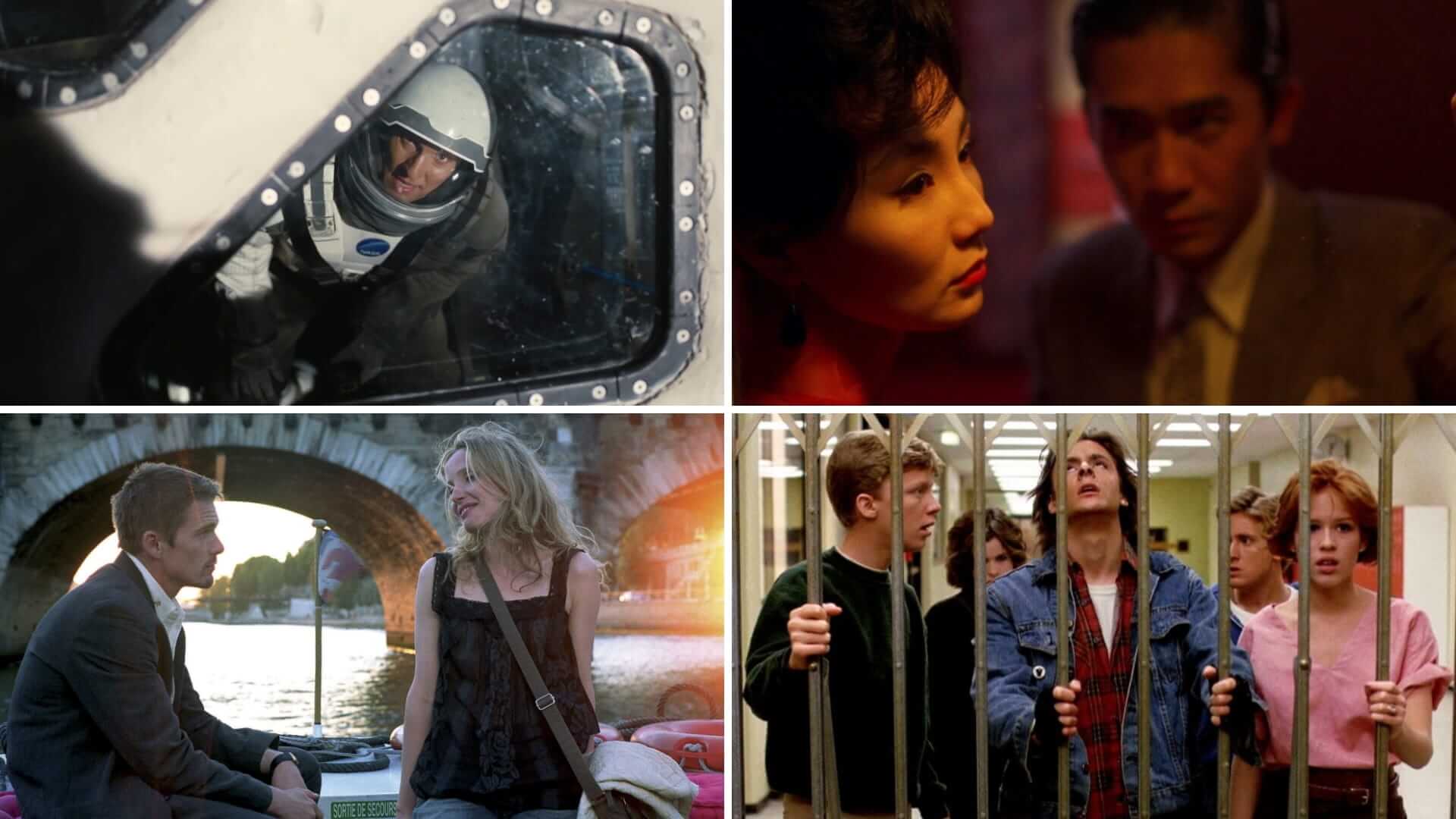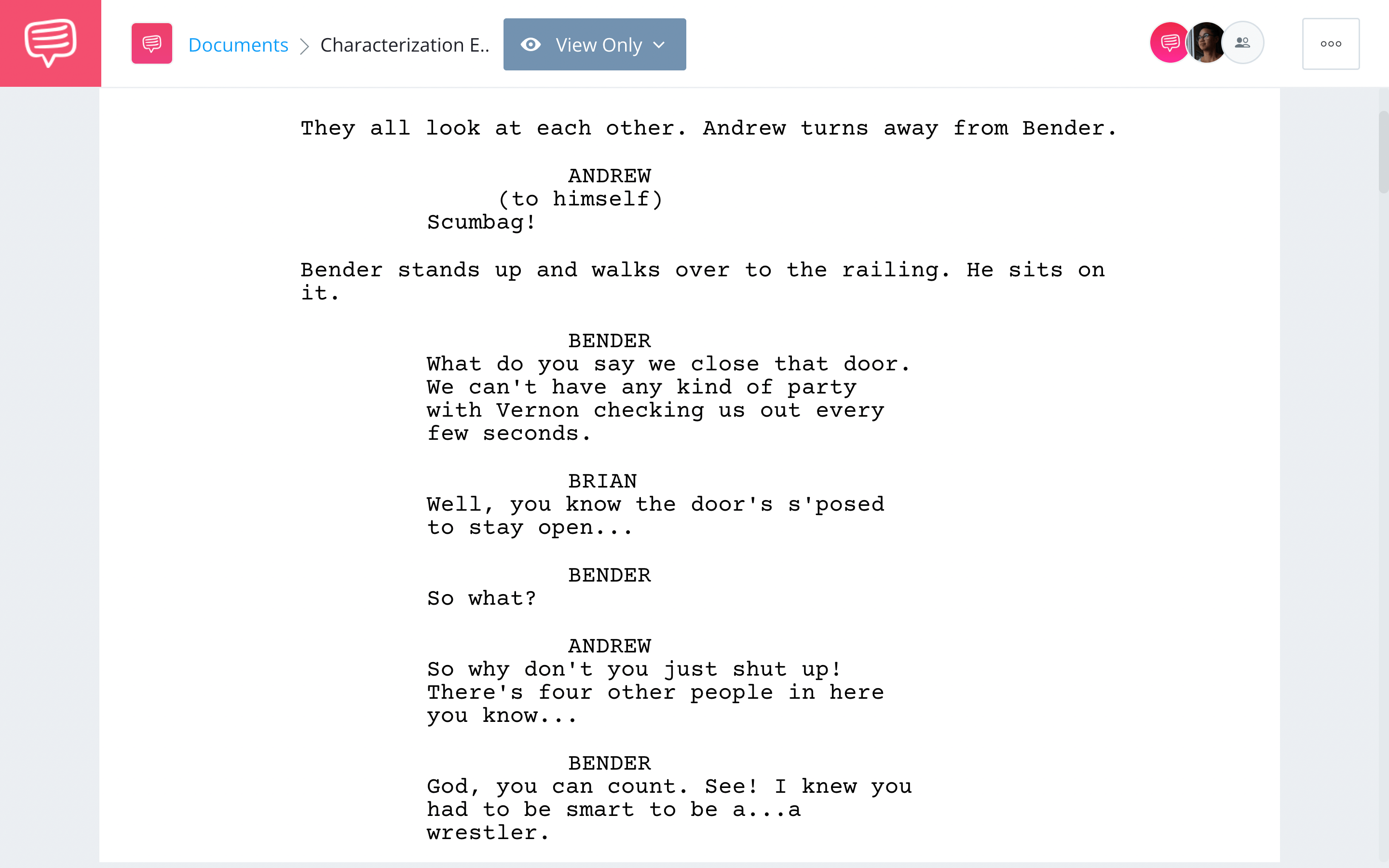Characterization is everything that makes a character a character; thoughts, feelings, and appearances included. We’re going to break down some characterization examples from The Breakfast Club, In The Mood for Love, and more to see how writers uniquely approach the art of making characters. By the end, you’ll know a variety of approaches to characterization!
CHARACTERIZATION IN FILM
How to build characters
How you write and construct characters in a screenplay is called characterization. Sometimes, as when writing a character study, you have the entire script to slowly build characters.
But in more plot-driven stories, being able to present a fully-formed and layered character is challenging. To deal with this, writers should know how to be efficient and purposeful with their characterizations.
There are two main types of characterization to keep in mind. Direct characterization is everything on the surface: job, physical attributes, age, etc. Indirect characterization is how you reveal character by "showing" not "telling." It is informed by their actions and how they move through the world.
Now, let's look at some characterization examples to see how this is done.
Examples of Characterization
Groups are perfect for showing contrast
Want to learn how to effectively characterize teenage characters? Look no further than the works of John Hughes. In particular, the excellent writing in The Breakfast Club screenplay.
The Breakfast Club is a perfect example of the strength of characterization. We imported Hughes' script into StudioBinder’s screenwriting software to take a look at a scene where characterization is used to great effect.
As you’re reading, pay attention to two things: the language characters use and how characters act in relation to each other. Click the image below to read the entire scene.
Direct Characterization Movie Examples • Read Characterization Example in The Breakfast Club
This scene is a masterclass in characterization. Why? Because it perfectly leverages the “group dynamic” to expose aspects of character we wouldn’t otherwise see. Take Bender for example: Bender hijacks the group dynamic despite saying he’s content being ostracized. As a result, Hughes builds irony through characterization.
In fact, Bender, Brian, Andrew, and Claire all express a desire to defend their social status. Through this, we’re able to see their insecurities. Bender is characterized as a “criminal.” Brian is characterized as a “brain.” Andrew is characterized as an “athlete.” Claire is characterized as a “princess.”
This early scene establishes trope characterizations with the goal of broadcasting stereotypes.
Now let’s take a look at how the scene is elevated in the film:
Characterization Sample • Characterization Examples in The Breakfast Club
This scene works well as a study in characterization. Not just for how it establishes tropes, but for how it sets up the ultimate deconstruction of those same tropes. In the end, our trope-ish cast of characters are characterized more fully; culminating in a classic speech that dismantles stereotypes – and that’s why The Breakfast Club is considered an all-time classic.
Characterize Examples
Actions speak louder than words
Is it possible to utilize characterization without a single line of dialogue? I’d say it’s absolutely possible — but don’t take my word for it, take Wong Kar-wai’s In the Mood for Love in its stead.
This is one of those characterization examples specifically suited to actors and directors — but artists of other disciplines can glean insight from it as well. As you’re watching, think about how framing, costume design, props, and posture give these characters life.
Examples of Characterization • Subtle Characterization in In the Mood for Love
We don’t hear any dialogue in this scene — but we’re still able to infer a lot about Su Li-zhen (Maggie Cheung) and Chow mo-Wan (Tony Leung Chiu-wai).
Let’s focus on props for example: in the opening, we see Su Li-zhen carrying a canister and purse. The canister tells us she’s going to get food. The purse implies she’s paying for herself. But these props also serve a non-utility purpose; that of characterization.
So, what do we think of her purse? It’s artsy for one, which suggests Su Li-zhen may like expressive design. It’s also trimmed with gold, which suggests she may be rich.
Later, we see Chow mo-Wan enter with a newspaper tucked between his arm and chest. Then, we see him eating, looking longingly forward at something. Is it the newspaper? Or is he simply lost in thought?
What does the unique framing of this shot say about how Wong Kar-wai wants us to see his character?
In the Mood for Love is regarded as one of the greatest movies of the 21st century. One reason: it’s chock-full of silent characterization.
Related Posts
Methods of Characterization Examples
Allow players to characterize
Characterization plays an important role in successful game-design; particularly in the role-playing genre. Over the years, we’ve seen a variety of games experiment with different styles of player-driven characterization. Most of the time, it starts with character creation.
Video game players love to design their own characters (especially for massively-multiplayer online games). This next video looks at the best character creators in video games.
As you’re watching, think about how character creators allow players to influence characterization before the game even begins.
What is an Example of Characterization? • Best Character Creators in Video Games by TripleJump
Character creation is one thing, but character CHOICE is a whole ‘nother. Some games — like BioWare’s Star Wars: The Old Republic — allow players to directly influence their narrative by choosing what happens at key story beats.
As a result, players are given unique agency over characterization. Want to be a lawful Sith? Or a chaotic Jedi? Let your actions do the talking. This next video spoofs the process of player choice in SWTOR.
Player-Controlled Characterization in Star Wars: The Old Republic, Spoofed by TerminalMontage
More and more games are giving their players the agency to influence characterization, through character creation, armoring, and dialogue; among other avenues. If you’re interested in the unique benefits of characterization in video games, consider playing Mass Effect, Dragon Age, and other player-driven choice games.
Characterization in Film Examples
It’s all about the inflection point
In every great heroic or anti-heroic story, the protagonist is forced to make a climactic choice that ensures nothing will ever be the same. This moment is called the inflection point: and there’s more than a few good examples in film.
Let’s name a few, beware for spoilers to Interstellar, Heat, and Before Sunset:
- Interstellar: Cooper decides to sacrifice himself so Brand can escape.
- Heat: When McCauley decides to live by his code: “Don't let yourself get attached to anything you are not willing to walk out on in 30 seconds flat if you feel the heat around the corner.”
- Before Sunset: When Jessie decides to stay with Celine instead of flying back home.
These inflection points always tell us about the true nature of a character; push come to shove, will they love it or leave it? The great films of the Italian Neorealism movement utilize character inflection points perhaps better than any others.
Here’s an example from Vittorio De Sica's Bicycle Thieves.
In Bicycle Thieves, Antonio only wants one thing: to get his stolen bicycle back. Over the course of an hour and a half, we see the world beat Antonio down, over and over. By the end, we see the despair on his face.
Antonio is left with one choice: will he maintain his morals, or will he sink to the level of society? The answer is ultimate proof of characterization.
Check out the clip below:
Indirect Characterization Examples in Movies • Characterization Examples in Bicycle Thieves
In the end, Antonio decides to steal a bicycle, just like the man stole a bicycle from him. I suppose the expression “an eye for an eye makes the world go blind” is true. Point proven by the post-war landscape of Italy, depicted in the final moments of Bicycle Thieves.
Up Next
What is Hamartia?
Our characterization examples barely scratched the surface on effective character construction. Want to learn more? Check out our next article on hamartia where we break down tragic character examples from The Great Gatsby, The Dark Knight, and more. By the end, you’ll know what hamartia means inside and out!

